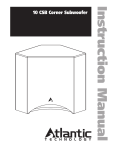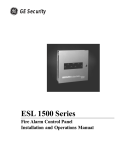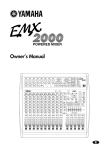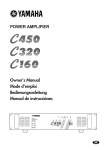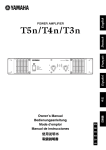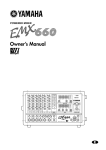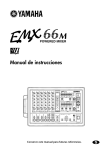Download Yamaha CP2000 Owner`s manual
Transcript
POWER AMPLIFIER Owner’s Manual POWER AMPLIFIER L 20 POWER TEMP PROTECTION POWER ON CLIP R 15 20 25 LEVEL 30 6 3 40 OFF L 0 Keep This Manual For Future Reference. 15 25 10 10 30 6 3 40 –dB R 0 E WARNING: THIS APPARATUS MUST BE EARTHED IMPORTANT THE WIRES IN THIS MAINS LEAD ARE COLOURED IN ACCORDANCE WITH THE FOLLOWING CODE: GREEN-AND-YELLOW : EARTH BLUE : NEUTRAL BROWN : LIVE As the colours of the wires in the mains lead of this apparatus may not correspond with the coloured markings identifying the terminals in your plug, proceed as follows: The wire which is coloured GREEN and YELLOW must be connected to the terminal in the plug which is marked by the letter E or by the safety earth symbol or coloured GREEN and YELLOW. The wire which is coloured BLUE must be connected to the terminal which is marked with the letter N or coloured BLACK. The wire which is coloured BROWN must be connected to the terminal which is marked with the letter L or coloured RED. * This applies only to products distributed by YAMAHA KEMBLE MUSIC (U.K.) LTD. Important Information i Important Information Please read the following before using the CP2000 Warnings • Do not allow water to enter this unit or allow the unit to become wet. Fire or electrical shock may result. • Connect this unit’s power cord only to an AC outlet of the type stated in this Owner’s Manual or as marked on the unit. Failure to do so is a fire and electrical shock hazard. • Do not scratch, bend, twist, pull, or heat the power cord. A damaged power cord is a fire and electrical shock hazard. • Do not place heavy objects, including this unit, on top of the power cord. A damaged power cord is a fire and electrical shock hazard. In particular, be careful not to place heavy objects on a power cord covered by a carpet. • Do not place a container with liquid or small metal objects on top of this unit. Liquid or metal objects inside this unit are a fire and electrical shock hazard. • If you notice any abnormality, such as smoke, odor, or noise, or if a foreign object or liquid gets inside the unit, turn it off immediately. Remove the power cord from the AC outlet. Consult your dealer for repair. Using the unit in this condition is a fire and electrical shock hazard. • Should this unit be dropped or the cabinet be damaged, turn the power switch off, remove the power plug from the AC outlet, and contact your dealer. If you continue using the unit without heeding this instruction, fire or electrical shock may result. • If the power cord is damaged (i.e., cut or a bare wire is exposed), ask your dealer for a replacement. Using the unit with a damaged power cord is a fire and electrical shock hazard. • Do not remove the unit’s cover. You could receive an electrical shock. If you think internal inspection, maintenance, or repair is necessary, contact your dealer. • Do not modify the unit. Doing so is a fire and electrical shock hazard. Cautions • When rack-mounting the unit, allow enough free space around the unit for normal ventilation. This should be: 10 cm behind, and 2 cm above. For normal ventilation during use, remove the rear of the rack or open a ventilation hole. If the airflow is not adequate, the unit will heat up inside and may cause a fire. • This unit has ventilation holes at the front and rear to prevent the internal temperature rising too high. Do not block them. Blocked ventilation holes are a fire hazard. • Clean the contacts of the phone plug before connecting it to the SPEAKERS jack of this unit. Dirty contacts may generate heat. • Use only speaker cables when connecting speakers to amplifier outputs. Using other types of cables is a fire hazard. • Hold the power cord plug when disconnecting it from an AC outlet. Never pull the cord. A damaged power cord is a potential fire and electrical shock hazard. • Do not touch the power plug with wet hands. Doing so is a potential electrical shock hazard. • Do not use this amplifier for any purpose other than driving loudspeakers. CP2000—Owner’s Manual ii Contents Package Contents The CP2000 package should contain the following items. Contact your Yamaha dealer if anything is missing. • CP2000 Power Amplifier • This manual Trademarks Yamaha is a trademark of Yamaha Corporation. All other trademarks are the property of their respective holders and are hereby acknowledged. Copyright No part of this Owner’s Manual may be reproduced or distributed in any form or by any means without the prior written authorization of Yamaha Corporation. © 2000 Yamaha Corporation. All rights reserved. Contents 1 Introduction . . . . . . . . . . . . . . . . . . . . . . . . . . . . . . . . 1 Welcome . . . . . . . . . . . . . . . . . . . . . . . . . . . . . . . . . . . . . . . . . . . . . . . . . . . . . . . . . . . 1 Front Panel . . . . . . . . . . . . . . . . . . . . . . . . . . . . . . . . . . . . . . . . . . . . . . . . . . . . . . . . . 2 Rear Panel . . . . . . . . . . . . . . . . . . . . . . . . . . . . . . . . . . . . . . . . . . . . . . . . . . . . . . . . . . 3 2 Hookup Examples . . . . . . . . . . . . . . . . . . . . . . . . . . . . 4 Stereo Hookup . . . . . . . . . . . . . . . . . . . . . . . . . . . . . . . . . . . . . . . . . . . . . . . . . . . . . . 4 Parallel Hookup . . . . . . . . . . . . . . . . . . . . . . . . . . . . . . . . . . . . . . . . . . . . . . . . . . . . . 5 Bridge Mode Hookup . . . . . . . . . . . . . . . . . . . . . . . . . . . . . . . . . . . . . . . . . . . . . . . . 6 3 Using the CP2000 . . . . . . . . . . . . . . . . . . . . . . . . . . . . 7 Installation . . . . . . . . . . . . . . . . . . . . . . . . . . . . . . . . . . . . . . . . . . . . . . . . . . . . . . . . . 7 Connecting Inputs . . . . . . . . . . . . . . . . . . . . . . . . . . . . . . . . . . . . . . . . . . . . . . . . . . . 7 Connecting Speakers . . . . . . . . . . . . . . . . . . . . . . . . . . . . . . . . . . . . . . . . . . . . . . . . . 9 Connecting S115 and S112 loudspeakers . . . . . . . . . . . . . . . . . . . . . . . . . . . . . . . . 11 Turning On the Power . . . . . . . . . . . . . . . . . . . . . . . . . . . . . . . . . . . . . . . . . . . . . . . 11 Protection System . . . . . . . . . . . . . . . . . . . . . . . . . . . . . . . . . . . . . . . . . . . . . . . . . . . 11 Daisy Chaining Inputs . . . . . . . . . . . . . . . . . . . . . . . . . . . . . . . . . . . . . . . . . . . . . . . 12 Troubleshooting . . . . . . . . . . . . . . . . . . . . . . . . . . . . . . . . . . . . . . . . . . . . . . . . . . . . 13 Appendix . . . . . . . . . . . . . . . . . . . . . . . . . . . . . . . . . . . 14 Specifications . . . . . . . . . . . . . . . . . . . . . . . . . . . . . . . . . . . . . . . . . . . . . . . . . . . . . . . 14 Dimensions . . . . . . . . . . . . . . . . . . . . . . . . . . . . . . . . . . . . . . . . . . . . . . . . . . . . . . . . 15 Block Diagram . . . . . . . . . . . . . . . . . . . . . . . . . . . . . . . . . . . . . . . . . . . . . . . . . . . . . . 16 CP2000—Owner’s Manual Introduction 1 1 Introduction Welcome Thank you for choosing the Yamaha CP2000 Power Amplifier. Based on a new improved version of Yamaha’s EEEngine amplifier technology, the CP2000 is a versatile two-channel power amplifier, offering high-power, superb sonic performance, and reliability, all backed by the Yamaha tradition of excellence in professional audio. CP2000 key features include • 650 W+650 W into 4Ω stereo, 450 W+450 W into 8Ω stereo. • 2,000 W into 4Ω bridged, 1,300 W into 8Ω bridged. • Yamaha Speaker Processing matches the CP2000 to the Yamaha S115 and S112 loudspeakers. • Three operating modes are provided: STEREO mode in which Channel L and Channel R operate independently, PARALLEL mode in which the channels operate independently but are both fed from the Channel L inputs, and BRIDGE mode in which both channels are combined to form a massive 2000 watt single-channel amplifier. • Improved EEEngine technology using MOSFET output devices. • Compared to conventional designs, EEEngine’s energy saving capabilities reduce power consumption by up to 50% and cut heat generation by up to 35%. • Built-in limiter prevents excessive output signal distortion, protecting both speakers and eardrums. • Electronically balanced XLR-type and 1/4" phone jack input connectors. • 5-way binding posts and 1/4" phone jack output connectors. • Signal and CLIP indicators on each channel provide signal presence and clip warning. • Relay-based protection system protects both amplifier and speakers if heatsink overheating occurs or a DC offset is detected at the outputs. • TEMP indicator warns of heatsink overheating. • Variable-speed low-noise fan regulates the system temperature even under the most demanding conditions. While the CP2000 is idle, the fan stops for silent operation. CP2000—Owner’s Manual 2 Chapter 1—Introduction Front Panel 6 7 POWER AMPLIFIER L 20 POWER TEMP ON LEVEL 6 3 40 OFF L 1 2 3 4 0 15 25 10 30 POWER R 20 25 PROTECTION CLIP 15 10 30 6 3 40 –dB R 0 5 A POWER switch This is the main POWER switch. Press to turn on the amplifier; press again to turn off. See “Turning On the Power” on page 11 for more information. B POWER indicator This indicator lights up when the CP2000 is turned on. C PROTECTION indicator This indicator shows the status of the protection system. See “Protection System” on page 11 for more information. D TEMP indicator This indicator lights up if the temperature of the CP2000’s heatsinks exceed 85 degrees Celsius. Note that this indicator only serves as a warning. It does not indicate operation of the protection system. E Level controls These controls are used to adjust the volume level of each channel. Since the gain of each amplifier channel is fixed, these controls work by attenuating the input signal from between –∞ dB and 0 dB. They are detented controls, which means they can be set to any one of 31 positions. Detents protect against accidental adjustment, allow repeatable setting, and make it easy to set both channels to the same volume. Usually these controls are set to maximum and volume levels are controlled from the source equipment, typically a mixer. F CLIP indicators These indicators light up when a channel’s output signal distortion exceeds 1% (i.e., clipping). Output signal clipping is usually due to excessive input signal levels. If a channel’s output signal does clip, that channel’s limiter circuit is activated to prevent further signal distortion. It’s okay for a CLIP indicator to light occasionally, but if it lights frequently, the LEVEL control should be turned down a little. G LEVEL indicators These indicators show the output signal level of each channel. The green indicators light up when the output voltage is 2 V or greater, while the yellow indicators light up when it’s 20 V or greater. CP2000—Owner’s Manual 3 Rear Panel Rear Panel 1 4 2 CHANNEL R CHANNEL L 2 1 3 2 CHANNEL L SPEAKERS (BRIDGE) STEREO BRIDGE PARALLEL OFF 1 (–) BRIDGE (+) INPUT CHANNEL R 1 NEUTRIK ON 2 1 3 YAMAHA SPEAKER PROCESSING 2 3 5 A INPUTs The inputs for each CP2000 channel comprise of one 1/4" phone jack and one XLR-3-31-type connector. Both connectors are electronically balanced, although they can also be used with unbalanced sources. See “Connecting Inputs” on page 7 for more information. See also “Hookup Examples” on page 4. Since the phone jack and XLR-type connector on each channel are internally connected, either connector can be used to distribute the input signal to another amplifier. See “Daisy Chaining Inputs” on page 12 for more information. B Mode switch This switch is used to select the amplifier’s mode of operation: STEREO, PARALLEL, or BRIDGE. STEREO—In this mode, which is typically used to amplify stereo sources, the L and R channels operate independently. PARALLEL—In this mode, the L and R channels operate independently but the input signal for both channels is sourced from the Channel L inputs. This mode is typically used with a mono source and allows independent volume control of two sets of speakers. BRIDGE—In this mode, the L and R channels are combined to form a massive 2000 watt single-channel amplifier. The input signal is sourced from the Channel L inputs, the volume level is set by using the Channel L LEVEL control, and the speakers are connected to the binding posts labelled BRIDGE. C YAMAHA SPEAKER PROCESSING switch This switch is used to activate the special EQ processing that optimizes the CP2000 for use with the Yamaha S115 and S112 loudspeakers. When other speakers are used, this switch should be set to OFF. See “Connecting S115 and S112 loudspeakers” on page 11 for more information. D SPEAKERS connectors The outputs for each CP2000 channel comprise of one 1/4" phone jack and one pair of 5-way binding posts. The 1/4" phone jacks accept 1/4" phone plugs, while the 5-way binding posts offer several methods of connection, including single or double banana plugs, spade lugs, or bare wires. See “Connecting Speakers” on page 9 for more information. See also “Hookup Examples” on page 4. CP2000—Owner’s Manual 4 Chapter 2—Hookup Examples E GND terminal For safety reasons it’s important that the CP2000 is grounded. The attached power cord has a three-pin plug, and if the ground terminal of the AC outlet to which it is connected is grounded, then the CP2000 will be grounded adequately via the power cord. If the AC outlet does not have a suitable ground terminal, a ground connection should be made to this ground terminal. If hum or noise occurs, try to eliminate it by connecting this terminal to a good ground point or the chassis of the mixer, preamp, etc. 2 Hookup Examples Stereo Hookup In STEREO mode, the L and R channels operate independently. This mode is typically used to amplify stereo sources. The following hookup example shows how the CP2000 can be used in STEREO mode. STEREO BRIDGE PARALLEL 2 CHANNEL R CHANNEL L 2 1 3 2 CHANNEL L SPEAKERS (BRIDGE) STEREO BRIDGE PARALLEL OFF 1 (–) BRIDGE (+) INPUT CHANNEL R 1 NEUTRIK ON 2 1 3 YAMAHA SPEAKER PROCESSING or ST OUT Mixer STEREO Notes: • The stereo input source is connected to the L and R inputs. • The Channel L and Channel R volume levels can be set independently. • Speakers can be connected to the 1/4" phone jacks and 5-way binding posts. CP2000—Owner’s Manual Total impedance: 2Ω min (1000 W) 4Ω (650 W) 8Ω (450 W) Total impedance: 2Ω min (1000 W) 4Ω (650 W) 8Ω (450 W) Parallel Hookup 5 Parallel Hookup In PARALLEL mode, the L and R channels operate independently but the input signal for both channels is sourced from the Channel L inputs. This mode is typically used with a mono source and allows independent volume control of two sets of speakers. The following hookup example shows how the CP2000 can be used in PARALLEL mode. STEREO BRIDGE PARALLEL 2 CHANNEL R CHANNEL L 2 1 3 2 CHANNEL L SPEAKERS (BRIDGE) STEREO BRIDGE PARALLEL OFF 1 (–) BRIDGE (+) INPUT CHANNEL R 1 NEUTRIK ON 2 1 3 YAMAHA SPEAKER PROCESSING Total impedance: 2Ω min (1000 W) 4Ω (650 W) 8Ω (450 W) Total impedance: 2Ω min (1000 W) 4Ω (650 W) 8Ω (450 W) MONO OUT Mixer PARALLEL Notes: • The input source must be connected to the Channel L inputs. • The Channel R inputs are inactive. • The Channel L and Channel R volume levels can be set independently. • Speakers can be connected to the 1/4" phone jacks and 5-way binding posts. CP2000—Owner’s Manual 6 Chapter 2—Hookup Examples Bridge Mode Hookup In BRIDGE mode, the L and R channels are combined to form a massive 2000 watt single-channel amplifier. The input signal is sourced from the Channel L inputs. The following hookup example shows how the CP2000 can be used in BRIDGE mode. STEREO BRIDGE PARALLEL 2 CHANNEL L CHANNEL R (BRIDGE) 2 1 3 STEREO BRIDGE PARALLEL OFF 1 2 (–) BRIDGE (+) INPUT CHANNEL R 1 CHANNEL L SPEAKERS NEUTRIK ON 2 1 3 YAMAHA SPEAKER PROCESSING Total impedance: 4Ω min (2000 W) 8Ω (1300 W) MONO OUT Mixer BRIDGE Notes: • The input source must be connected to the Channel L inputs. • The volume level is set by using the Channel L LEVEL control. • The Channel R inputs and LEVEL control are inactive. • The speakers must be connected to the 5-way binding posts. • The 1/4" phone jack outputs must not be used. CP2000—Owner’s Manual 7 Using the CP2000 3 Using the CP2000 Installation The CP2000 can be mounted in a standard rack and requires 2 rack-space units. In addition to the front-panel rack-mounting holes, the CP2000 also features support brackets at the rear, which offer additional support and should be fixed to the rear of the rack. The CP2000 can also be placed horizontally on the floor or a suitable table. The CP2000 uses a variable-speed low-noise fan to regulate the system temperature, which draws air in from the front and expels it from the rear. For correct operation, it’s important that the air flow at the front and rear of the CP2000 is not blocked or restricted in any way. If the CP2000 is mounted in a portable rack with removable front and rear covers, be sure to remove the covers before using the CP2000. Connecting Inputs Warning: Turn off all equipment before making any connections. The inputs for each CP2000 channel comprise of one 1/4" phone jack and one XLR-3-31-type connector. Both connectors are electronically balanced, although they can also be used with unbalanced sources. For optimum performance, use only quality screened cables for input connections. Under no circumstances should you connect more than one sound source to the same channel. The inputs are designed to work with line-level sources, such as mixers, CD players, and other professional audio equipment. The 1/4" TRS (Tip-Ring-Sleeve) phone jacks are wired as follows: sleeve–ground, tip–hot (+), and ring–cold (–). TRS phone plugs should be wired as follows. Tip (hot) 1/4" TRS phone plug Ring (cold) Sleeve (ground) To connect an unbalanced source to an INPUT jack, connect the ring (cold) terminal to the sleeve (ground) terminal, as shown. Tip (hot) 1/4" TRS phone plug Ring (cold) Sleeve (ground) The XLR-type connectors are wired as follows: pin 1–ground, pin 2–hot (+), and pin 3–cold (–). Male XLR plugs should be wired as follows. Male XLR plug 1 (ground) 3 (cold) 2 (hot) CP2000—Owner’s Manual 8 Chapter 3—Using the CP2000 To connect an unbalanced source to an INPUT XLR, connect pin 3 (cold) to pin 1 (ground), as shown below. Male XLR plug 1 (ground) 3 (cold) 2 (hot) The following table shows which inputs, LEVEL controls, and signal and CLIP indicators are active in each CP2000 mode. Channel R L CP2000—Owner’s Manual Item STEREO PARALLEL BRIDGE INPUT connectors O X X LEVEL control O O X Signal & CLIP indicators O O O INPUT connectors O O O LEVEL control O O O Signal & CLIP indicators O O O 9 Connecting Speakers Connecting Speakers Warning: Turn off all equipment before making any connections. The outputs for each CP2000 channel comprise of one 1/4" phone jack and one pair of 5-way binding posts. The 1/4" phone jacks accept 1/4" phone plugs, while the 5-way binding posts offer several methods of connection, including single or double banana plugs, spade lugs, or bare wire. For optimum performance, use quality speaker cables with a suitable power rating. Tip (+) 1/4" phone plug Phone plugs should be wired as follows. Sleeve (–) When connecting to the binding posts, be sure to connect the speaker cables with the correct polarity, otherwise, the sound quality will be affected. The plus (+) terminal on the speaker must be connected to the binding post labelled (+), and the (–) terminal on the speaker must be connected to the binding post labelled (–). Caution for Speaker Connection Turn off the POWER switch. 2 Before connecting any speakers, remove the protective cover by unscrewing the two fixing screws shown here. Be sure to replace the cover when you’ve finished making your connections. 3 When attaching bare-ended speaker cables, strip off about 15 mm of insulation, unscrew the binding posts, and insert the bare wires through the holes in the posts, and then tighten the binding posts. Make sure that none of the bare wires are splayed in such a way that they may cause a short. Screw 1 15mm 1 1 When attaching speaker cables with spade lugs, unscrew the binding posts, place the spade lugs on the posts, and then tighten the binding posts. 4 Reattach the protective cover over the speaker terminals. European Specifications Only This mark indicates a dangerous electri2 1 1 2 cally live terminal. When connecting an external wire to this terminal, it is necessary CHANNEL R CHANNEL L either to have “a person who have received SPEAKERS appropriate guidance on handling” make the connection or to use leads or a cord that have been manufactured in such a way that the connection can be made simply and without problem. (—) BRIDGE (+) CP2000—Owner’s Manual 10 Chapter 3—Using the CP2000 The following table shows which outputs can be used in each CP2000 mode and the minimum speaker impedance. Note that this is the total speaker impedance that can be connected to each channel. For example, a 2Ω minimum means that you could connect a single 2Ω speaker, two 4Ω speakers in parallel, or four 8Ω speakers in parallel. Mode Item STEREO PARALLEL Phone jack (2) Channel R X 2Ω min Binding posts (1) 4Ω min Binding posts (1) Channel L BRIDGE 2Ω min Phone jack (2) X In the STEREO and PARALLEL modes, you can connect speakers to a channel’s 1/4" phone jack and binding posts simultaneously, so long as the total impedance is not less than 4Ω. In BRIDGE mode, the speakers must be connected to the binding posts labeled “BRIDGE” and the 1/4" phone jacks cannot be used. 2 1 1 2 STEREO and PARALLEL mode only (–) BRIDGE (+) CHANNEL R CHANNEL L SPEAKERS 4Ω min 4Ω min (total 2Ω min) 4Ω min 4Ω min (total 2Ω min) When connecting speakers, it’s important that the total impedance is not less than the minimum specified. In STEREO and PARALLEL modes, the minimum impedance is 2Ω, and for BRIDGE mode it’s 4Ω. When speakers are connected in parallel, the impedance is reduced, as shown in the following examples. When connecting multiple speaker cabinets, make sure the total impedance is not less than the minimum. Total = 2Ω Total = 4Ω Total = 2Ω 8Ω 8Ω 4Ω 8Ω 8Ω 4Ω 8Ω 8Ω See the “Hookup Examples” on page 4 for more information on connecting speakers. CP2000—Owner’s Manual 11 Connecting S115 and S112 loudspeakers Connecting S115 and S112 loudspeakers The CP2000 features special EQ processing that optiOFF ON mizes the CP2000 for use with the Yamaha S115 and S112 loudspeakers (especially the 115IV). This processYAMAHA SPEAKER PROCESSING ing is turned on and off by using the YAMAHA SPEAKER PROCESSING switch. Yamaha loudspeakers should be connected just like any other speaker, and for best performance the YAMAHA SPEAKER PROCESSING switch should be set to ON. When using other speakers, make sure the YAMAHA SPEAKER PROCESSING switch is set to OFF. Turning On the Power To prevent audible thumps and clicks, turn on your audio equipment in the following order (reverse this order when turning off your equipment)—sound sources, mixer, CP2000. 1 POWER Press the [POWER] switch to turn on the CP2000. The CP2000 starts up and the POWER indicator lights up. ON OFF The output relay closes, connecting the speakers, several seconds after the CP2000 is turned on. 2 Press the [POWER] switch again to turn off the CP2000. The POWER indicator goes out. The output relay opens, disconnecting the speakers, immediately the CP2000 is turned off. Protection System The CP2000 features a relay-based protection system to protect itself and the connected speakers against damage due to abnormal operating conditions. When the protection system is active, the speakers are disconnected from the CP2000 and the PROTECTION indicator lights up. PROTECTION When the CP2000 is turned on, the output relay remains open, disconnecting the speakers, for approximately three seconds. During this time, the PROTECTION indicator lights up. When the protection system has confirmed that no abnormal conditions exist, the output relay closes, connecting the speakers, and the PROTECTION indicator goes out. In addition to allowing the protection system to perform various checks, protects the speakers against thumps and clicks as the CP2000 starts up. When the CP2000 is turned off, the output relay opens immediately, disconnecting the speakers, and preventing unwanted sound as the CP2000 shuts down. If during normal operation the protection system detects that a heatsink has overheated or a DC offset is present at a speaker output, the output relay opens, disconnecting the speakers, and the PROTECTION indicator lights up. Once the heatsink has cooled down, or the DC offset removed, the protection system automatically closes the output relay, reconnecting the speakers, the PROTECTION indicator goes out, and normal operation is resumed. Heatsink overheating is typically caused by inadequate ventilation and it’s important that you investigate the cause and resolve it (see page 13 for more information). Another layer of protection is offered by the thermostatic cutout (auto-reset type) built into the CP2000 power supply transformer. If abnormal operating conditions, such as a shorted load or overload, continue for a long period of time, the thermostatic cutout CP2000—Owner’s Manual 12 Chapter 3—Using the CP2000 disconnects the AC power when the transformer reaches a certain temperature and the POWER indicator goes out. Once the transformer has cooled down, the thermostatic cutout automatically closes, reconnecting the power, the POWER indicator lights up, and normal operation is resumed. Daisy Chaining Inputs Since the phone jack and XLR-type connector on each input channel are internally connected, input signals can easily be distributed to other amplifiers by daisy chaining the inputs, as shown below. 2 CHANNEL R CHANNEL L 2 1 3 2 CHANNEL L SPEAKERS (BRIDGE) STEREO BRIDGE PARALLEL OFF 1 (–) BRIDGE (+) INPUT CHANNEL R 1 NEUTRIK ON 2 1 3 YAMAHA SPEAKER PROCESSING 2 CHANNEL L (BRIDGE) 2 1 3 STEREO BRIDGE PARALLEL OFF NEUTRIK ON 2 1 3 YAMAHA SPEAKER PROCESSING ST OUT Mixer CP2000—Owner’s Manual 1 (–) BRIDGE (+) INPUT CHANNEL R 1 CHANNEL R CHANNEL L SPEAKERS 2 Troubleshooting 13 Troubleshooting The following table explains the operation of the CLIP, TEMP, and PROTECTION indicators, typical situations in which they may light up, and what action to take if and when they do. Symptom Remedy Protection System POWER indicator not lit Power cable disconnected or amplfier turned off. Make sure the power cable is connected properly and the POWER switch is in the ON position. — No sound Input signal not connected or LEVEL controls turned down. Check the input connections and LEVEL control settings. — Stereo sources sound odd Incorrect speaker polarity. Check the polaity of the speaker connections and correct if necessary. — The input signal is too high. Reduce the input signal level, or turn down the LEVEL control. The speaker impedance is too low. Ensure that the total speaker impedance is not less that 2Ω (STEREO/PARALLEL) or 4Ω (BRIDGE). There is a short at the speaker terminals, amplifier terminals, or in the speaker cable. Locate and remove the short. The heatsink temperature has exceeded 85˚C. Make sure that the air vents are not blocked and improve the airflow around the amplifier. The heatsink temperature has exceeded 90˚C. Make sure that the air vents are not blocked and improve the airflow around the amplifier. A DC offset of ±2 V or more was detected at the amplifier’s outputs. Contact your Yamaha dealer or service center. CLIP indicator lit TEMP indicator lit PROTECTION indicator lit Possible Cause The limiter circuit prevents further clipping distortion. The heatsink temperature warning circuit activates. The protection circuit activates, opening the output relay and disconnecting the speakers. The output relay closes automatically when the heatsink has cooled down, or the DC fault is removed. CP2000—Owner’s Manual 14 Appendix Appendix Specifications Power Output Level 8Ω/STEREO 450 W + 450 W 4Ω/STEREO 650 W + 650 W 8Ω/BRIDGE 1300 W 2Ω/STEREO 1000 W + 1000 W 4Ω/BRIDGE 2000 W 1 kHz, THD+N=1% 1 kHz 20 ms, non-clip Power Bandwidth THD+N=0.2% (half power) 10 Hz–40 kHz Total Harmonic Distortion (THD+N) 4-8Ω/STEREO 20 Hz–20 kHz (half power) 8Ω/BRIDGE 0.1% Intermodulation Distortion 60 Hz:7 kHz, 4:1, half power 4-8Ω/STEREO 8Ω/BRIDGE 0.1% Frequency Response 8Ω, Po=1W 0 dB, +0.5 dB, –1 dB f=20 Hz—50 kHz Channel separation Half power, RL=8Ω LEVEL=max., input 600Ω shunt ≥70 dB, 1 kHz Residual Noise LEVEL=min., 12.7 kHz LPF, IHF-A network ≤ –70 dB S/N Ratio 12.7 kHz LPF 104 dB Damping Factor RL=8Ω, 1 kHz ≥200 Sensitivity LEVEL=max., rated power into 8Ω +4 dB Voltage Gain LEVEL=max. 33.8 dB Input Impedance 30 kΩ (balanced), 15 kΩ (unbalanced) Front panel POWER switch (push on/push off) LEVEL attenuator (31 position) x2 Rear panel Mode switch (STEREO/BRIDGE/PARALLEL) YAMAHA SPEAKER PROCESSING switch (ON/OFF) Input XLR-3-31 type (balanced) L+R 1/4" phone jack (balanced) L+R Output 1/4" phone jack L+R 5-way binding post x1 POWER x1 (green) PROTECTION x1 (red) TEMP x1 (red) heatsink temp ≥85°C CLIP x2 (red) SIGNAL x2 (green) output voltage ≥2 V x2 (yellow) output voltage ≥20 V Controls Connectors Indicators CP2000—Owner’s Manual Dimensions 15 Protection Circuit POWER switch on/off mute DC detection TEMP (heatsink temp ≥90°C) PC limiter: RL≤1Ω Fan Circuit Stop–low speed (50°C)–variable–high Speed (70°C) Limiter Circuit Comp: THD≥0.5% Power requirements U.S.A. & Canada 120 V AC, 60 Hz Europe 230 V AC, 50 Hz Australia 240 V AC, 50 Hz Idle Power Consumption 30 W 1/8 Power Consumption (4Ω) 400 W Maximum Power Consumption (4Ω) 2000 W Dimensions (W × H × D) 480 × 88 × 416 mm (18.9 x 3.46 x 16.4 inches) Weight 14 kg (30.9 lbs) AC Power cord length 2.3 m 0 dB=0.775 V rms, half power=1/2 power output level 410 416 Dimensions 88 480 Specifications and external appearance subject to change without notice. For European Model Purchaser/User Information specified in EN55103-1 and EN55103-2. Inrush Current: 65A Conformed Environment: E1, E2, E3 and E4 CP2000—Owner’s Manual V617350 R1 1 IP 20 NP Printed in Taiwan CHANNEL R INPUT CHANNEL L (BRIDGE) (PARALLEL) BA BA POWER SW POWER • ON • OFF • ON • OFF INV POWER CIRCUIT CHANNEL R PARALLEL ATT BRIDGE STEREO YAMAHA SPEAKER PROCESSING CHANNEL L ATT E –B +24 E –24 +B Limiter Limiter FAN CLIP Protection Circuit Rch Power Amp Temperature Sensor (Heat Sink) CLIP Lch Power Amp SIGNAL TEMP PROTECTION SIGNAL CHANNEL R L+R BRIDGE CHANNEL L SPEAKERS Block Diagram Pro Audio & Digital Musical Instrument Division P.O. Box 3, Hamamatsu, 430-8651, Japan YAMAHA CORPORATION
This document in other languages
- română: Yamaha CP2000
- français: Yamaha CP2000
- español: Yamaha CP2000
- Deutsch: Yamaha CP2000
- русский: Yamaha CP2000
- Nederlands: Yamaha CP2000
- dansk: Yamaha CP2000
- polski: Yamaha CP2000
- čeština: Yamaha CP2000
- svenska: Yamaha CP2000
- italiano: Yamaha CP2000
- português: Yamaha CP2000
- Türkçe: Yamaha CP2000





















